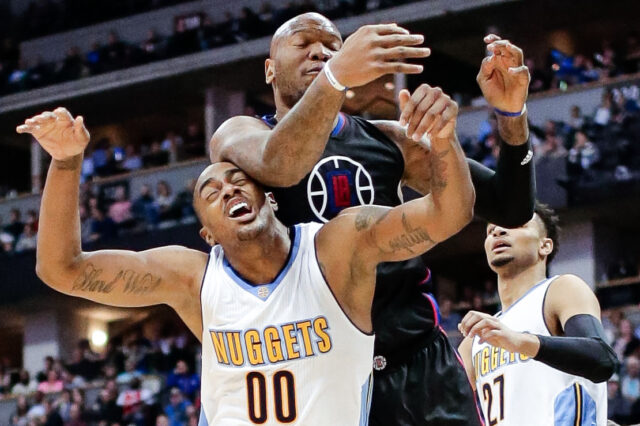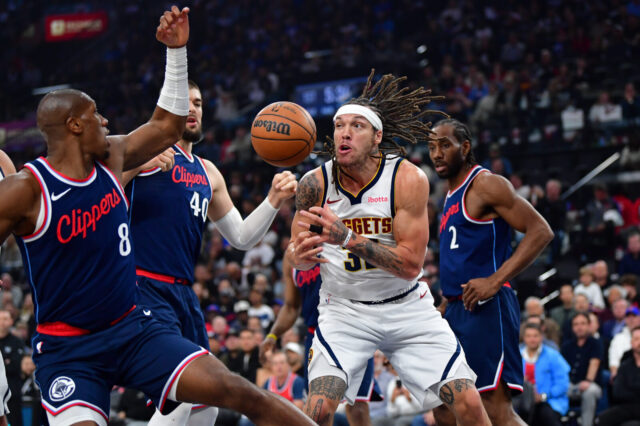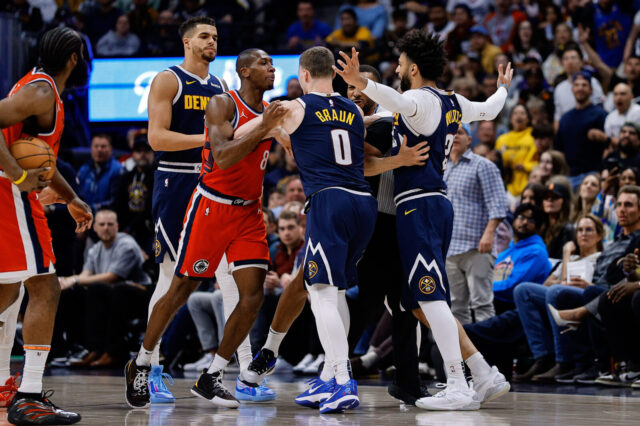Two weeks ago I wrote about the challenge of running pick and rolls between Emmanuel Mudiay and Mason Plumlee. Defenses can sag so deep into the paint off of Plumlee when he sets the screen, clogging up driving angles to the basket. Meanwhile, the on-ball defender can duck under the screen, unafraid of conceding a Mudiay pull-up three off of the dribble. Defending the screen this way takes away the drive and the roll, effectively coaxing Mudiay into a pull-up mid-range jumper which is among the worst shots in basketball.
But it’s not a fool-proof defense, it just forces Denver to build in some creative counters. The team can make a few go-to adjustments with Plumlee when the defense starts to ignore his screens. Let’s take a closer look at those adjustments in this week’s spotlight.
This content is no longer available.
Playing small
The Nuggets are already forced into one adjustment that helps open up the paint for this duo. With Paul Millsap out for the foreseeable future, Denver has gone to a lot more small-ball, especially in their second unit around Mudiay and Plumlee. In addition to providing more shooting threats around the perimeter, these lineups allow for a couple of key types of actions that Denver can make with their second unit.
Veer
I first mentioned this adjustment after the Portland game, when Jusuf Nurkic completely ignored Plumlee, sticking close to the paint on all ball screens and Plumlee spot-ups. Veer uses the ball-screen as a disguise for an off-ball screen for a sharp-shooter. The Clippers used this action a lot last season to get open looks for their sharpshooter, JJ Redick. Watch how DeAndre Jordan fakes the ball-screen before bee lining it to set a screen for Redick. Jordan’s defender prepares to sink into the paint for a ball-screen going one direction which takes him out of position to help on the pindown.
Malone ran this exact set two seasons ago, ironically enough, when Nurkic was the screener. So we know that it is in the playbook.
It might be wise for Denver to dust off this action and make it a larger part of their base PnR attack with their second unit. There is no shortage of players to run this for. Will Barton is the best option since he is great at shooting off of the catch and attacking a big downhill. Gary Harris is slightly less effective when attacking a big one-on-one but he’s elite at shooting off of the catch and turn the corner well enough to be effective. And Jamal Murray has the craftiness to catch and shoot, dribble to the elbow and pull up, or make the read to Plumlee on the roll. Even Juancho Hernangomez and Wilson Chandler can make this set work in a pinch.
Seal
One thing teams around the league are doing when bigs drop deep into the paint on ball-screens is to actually just set the screen on the big instead of on the ball. This works well as a change of pace for teams that have a point guard with a good first step (the examples in this video are John Wall, Russell Westbrook, and Kyrie Irving). It works because the on-ball defender anticipates the screen and plans to fight over the screen rather than to contain the ball, one on one. The big anticipates the opposite, that his job will be to contain the ball one-on-one, not fight through a screen.
One of Mudiay’s best strengths is his ability to blow by the first line of defense. He has a quick first step and the size to attack downhill if he can get a clear lane to the basket. This option won’t work for every ball-screen. It works in part because it catches defenses off-guard but even if it is just a curveball, it should force the defense to play the Mudiay-Plumlee pick and roll a bit more honestly.
Double-high screens
Denver has gone to this action a little bit so far this season but it is probably worth trying it a bit more, especially with a second unit that will feature a great roll big in Plumlee and solid three-point shooting bigs in Jokic, Lyles, Hernangomez, and Chandler. Denver runs a lot of delay screens and pistol action as part of their early offense in order to get the ball moving but double drag screens can provide a different look that still winds up getting the team into proper floor balance and into pick and rolls.
One reason double drag screens work is because it makes it very difficult for the defense to go under both screens. Go under the first high screen and the second screener gets to set the second screen a few steps lower. Instead, most teams send the on-ball defender over the top of both screens. For the offense, the trick is timing the roll and pop perfectly with the dribble attack to put the most pressure on the defense. This requires a fair amount of chemistry between both bigs and the point guard.
In the first example, Mudiay shakes off the play and calls his own number. The play call appears to be for Lyles to receive a screen from Faried after the drag screens. Instead, Mudiay pulls up for a lightly contested mid-range jumper with 18 seconds on the shot clock and nobody in rebounding position. You can see Faried’s frustration at the decision.
Mudiay seems to prefer this shot out of double drag screens.
The execution on all three of these could be much better. Rolling the first screener and popping the second will be easier for Mudiay to time and also leads the pop guy right into a DHO against a scrambled defense if a shot isn’t immediately open. Mudiay can also slow down a bit. In all three instances he attacks the screens before they are set, allowing his defender to fight through easier. He also turns the corner quickly on all three examples. If the defender trails the screens, he’ll have a great opportunity to stick his defender in jail and allow the roll guy an extra second to get to the rim for rebounding position or for the lob.
This content is no longer available.
The Nuggets have actually started running that double high screen play for Lyles quite a bit lately, not just with Mudiay. They probably need to add some more counters off of it since Utah seemed well prepared for the action but the play still works to create a switch. In both instances in the Utah game, Lyles was able to attack a switch.
One major difference on the defensive end between Millsap and Faried is that Millsap almost always makes the smart, early, and less flashy read while Faried routinely hunts for big plays. In the clip below, watch how Faried sees Marc Gasol rolling to the rim but rather than rush over to force him to pick up his dribble, Faried tries to time him to get a monster blocked shot. It’s so clear that Faried sees the play develop but chooses to react slowly in an attempt to get a block, rather than make the simple play. Gasol instead baits Faried into a jump before dropping the ball off for a wide open dunk.
In the clip below, the Nuggets play 20 seconds of excellent defense, culminating with Harris doubling the post and four great rotations behind him. Unfortunately, Wilson Chandler takes the play off and a great defensive effort goes down the drain. Part of the issue here appears to be communication. Harris and Chandler are two very quiet guys but had either of them communicated on the play, the result would’ve likely been a defensive stop.
I loved this series of plays in the Sacramento game. Jokic saw how slow Zach Randolph was recovering on the closeout so he set the ball screen toward the sideline to create enough space for a top of the key jumper. On the next possession, Juancho’s man slides over to stunt at Jokic to discourage the easy jumper but Juancho reads it perfectly and slides away from the ball before cutting to the basket for the dunk. This is read and react basketball and Juancho has a lot of great instincts for it.
Here’s a great example of Faried’s gravity in the dunker spot and Jokic’s craftiness as a facilitator. As Jokic receives the ball on the roll, watch closely how Faried’s man tries to stunt at Jokic to make him pick up his dribble without fully committing. If Jokic stops there, the defense can recover. Instead, Jokic takes a small dribble to force the defense to fully commit to their rotation which allows just enough time for him to get a pass to a wide open Murray in the corner. Even though Murray misses, the Nuggets now have a positioning advantage for offensive boards. That patience by Jokic on the pass was the difference between creating an offensive advantage or letting the defense get settled back after the initial screen.
In order for the Nuggets offense to get humming back to the level it was at last year, the wings and guards will have to tighten up their cuts, screens, and reads. Examples like the play below are far too common this season, where the wings run through the motions of a play without just reading and reacting to the defense. This play technically calls for Barton to set a pindown for Harris who then comes off of the Jokic handoff, sort of a criss-cross of screens.
Barton half-efforting the screen is only part of the issue. Had he been fully locked in, he would’ve seen a slip opportunity, curling off of Jokic and cutting toward the basket for the easy lay in. This was Nuggets basketball last season, guys working within the framework of an offense but constantly reading the defense and finding cutting opportunities within that framework. The team has appeared much more focused on sticking to the book so far this season but perhaps that will start to change now as the roster looks more like last year’s roster.
This content is no longer available.
Jamal Murray | NOP @ DEN | 31 points, 13-18 FG, 16 first quarter points
The Nuggets are a different team when Jamal Murray plays well. He came out firing in this game and knocked down just about everything he put up. Off balance jumpers, catch-and-shoot threes, drives to the basket. Murray had the complete arsenal working in this game and it helped Denver blow the doors off of the Pelicans at home in what turned out to be one of their best wins of the season.
Gary Harris | DEN @ LAL | 20 points, 7-13 FG, 4-6 3FG
The Nuggets blowout loss to the Lakers was among the team’s worst losses of the year so it’s hard to pick a bright spot but if there was one it was Gary Harris. Garris is Mr. Reliable. He rarely makes egregious mistakes, he defends his position, and he knocks down open shots. I’m a bit surprised that this is his first game ball of the year but perhaps that make sense. Garris is always really good but rarely the lead guy.
Will Barton | DEN @ SAC | 25 points, 6 rebounds, 5 assists
Like so many times this year, this could’ve easily gone to Jokic who I thought orchestrated the offense beautifully but I’m giving the nod to Barton because without his aggression and shot making, Denver probably wouldn’t have survived that ugly end of the first quarter. Barton played 37 minutes in this game and probably would’ve played more had Denver not pulled away in the 2nd half. Wilson Chandler will return to the starting lineup once he recovers from a sore back but Denver’s best lineups might feature Barton at small forward as an extra elite floor spacer with either Chandler or Faried at power forward.
Nikola Jokic | MEM @ DEN | 28 points, 13 rebounds, 8 assists
This was one of the best games of Jokic’s career, not just for the absurd statline but also because of how Jokic approached the game, especially the 4th quarter. Jokic looked to attack Marc Gasol early in the post before settling into his comfortable role as facilitator for most of the first three quarters. When the second unit blew a double-digit lead late in the 3rd, Jokic started the 4th by demanding the ball in the post and going to work. He scored 14 of his 28 points in that final quarter and grabbed 7 rebounds. It’s too early to declare that Jokic has transformed into a leader and a guy willing and able to put a team on his back night after night, but it is a step in the right direction.
Gary Harris | DEN @ UTA | 18 points, -23
I thought for a long time about who to award this game ball. No one on the Nuggets roster played well. I almost gave the game ball to Torrey Craig since he got his first real NBA experience but I want this graphic to tell a real and honest story at the end of the season and be a representation of which players were the team’s best players most frequently throughout the year. So I gave it to Harris, the guy with the worst +/- because, although he was awful, he at least scored a few points.


